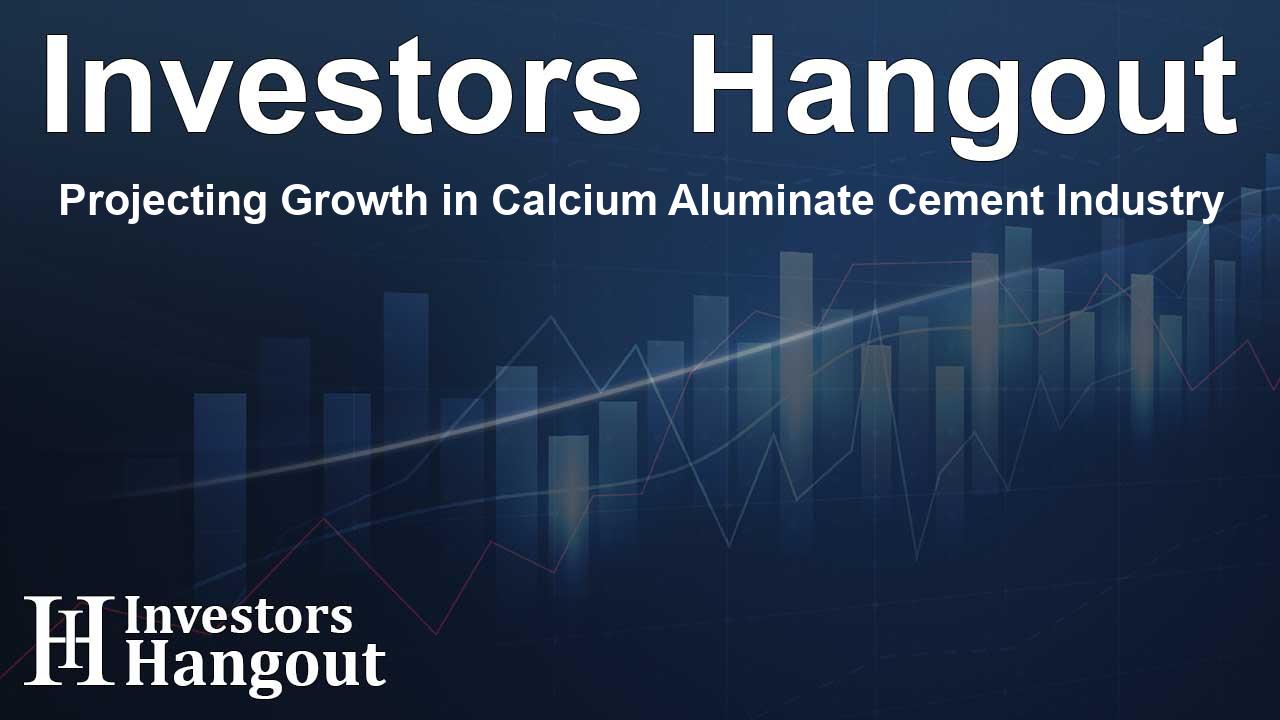Projecting Growth in Calcium Aluminate Cement Industry

Overview of the Calcium Aluminate Cement Market
The global calcium aluminate cement market is set for significant growth, expected to expand from a valuation of US$ 4.5 billion to US$ 7.5 billion, reflecting a compound annual growth rate (CAGR) of 5.7%. This growth is primarily driven by refractory applications, especially in the steel industry, where the shift to electric arc furnaces (EAFs) has encouraged the use of diverse innovative solutions.
Key Applications and Industry Trends
One notable trend is the increasing reliance on calcium aluminate cement in the steel sector, where it accounts for nearly 46% of global demand. EAFs, known for their reduced emissions, need high-performance materials that offer durability under extreme conditions. Countries leading in EAF development are witnessing an uptick in their demand for calcium aluminate cement, with India seeing a notable 22% increase in refractory castables and China implementing stringent CAC requirements for steel production.
Innovations in Water Infrastructure
Beyond steel, calcium aluminate cement is essential in wastewater infrastructure. Enhanced durability against environmental challenges has led to its use in regions that allocate substantial budgets for improving water systems. For instance, recent policies in various regions are mandating the use of modified concrete mixes to prolong service life significantly. Projects like the Deep Tunnel Sewerage System in Singapore highlight the innovative use of 12,000 tons of CAC to combat corrosion from marine environments.
Emerging Trends in the Market
Research shows that emerging applications, such as 3D printing components from CAC, are poised to capture a market share of about 9% annually for niche applications like nuclear waste containment. This innovative direction reflects the potential of CAC materials to address significant environmental and engineering challenges.
Key Market Drivers
The calcium aluminate cement market benefits from various drivers, including:
- Expanding applications across high-temperature sectors.
- Concrete solutions needed for infrastructure expansion.
- Growing requirement for specialized construction materials.
Challenges and Opportunities
However, challenges like fluctuating raw material prices can hinder growth. Recent price increases for bauxite, a primary ingredient, have prompted manufacturers to source alternatives, ensuring cost-effectiveness without compromising the quality of the final product.
Competitive Dynamics
In terms of suppliers, Almatis currently holds a substantial share of the market by focusing on high-purity calcium aluminate cement tailored for specific applications, including nuclear and aerospace industries. Similarly, Imerys is establishing its footprint through olive and sustainable practices to optimize production efficiency and minimize environmental impact.
Market Segmentation
The market can also be segmented based on various factors:
- By Product Type: Includes different grades of calcium aluminate cement like CAC 40 and CAC 50.
- By Form: Mainly exists in powdered and block forms, with powders dominating market share due to mix-design flexibility.
- By Application: Various applications include rapid hardening mortars, sewage pipelines, and refractory applications, all underscoring the material's versatile nature.
Looking Ahead
The calcium aluminate cement market’s landscape is evolving, guided by sustainability and efficiency. As companies adapt to emerging trends and challenges, we can expect to see innovations enhancing product formulations, especially those that align with eco-friendly practices and address construction challenges.
Frequently Asked Questions
What is calcium aluminate cement?
Calcium aluminate cement is a special type of cement made primarily from limestone and bauxite, known for its rapid hardening properties and resistance to corrosion.
Why is calcium aluminate cement important in the steel industry?
It is crucial in the steel industry due to its high resistance to thermal shock and chemical erosion, required for processes like EAF manufacturing.
What challenges does the calcium aluminate cement market face?
Challenges include fluctuating raw material costs and the need for skilled applicators to ensure proper usage and curing methods.
How is recycled material being used in calcium aluminate cement production?
Manufacturers are exploring the incorporation of recycled materials, such as aluminum dross, to reduce reliance on virgin bauxite and lower production costs.
What are the future prospects for calcium aluminate cement?
The future looks promising with ongoing innovations, particularly in sustainable practices and demand from new sectors such as nuclear waste containment and large infrastructure projects.
About The Author
Contact Logan Wright privately here. Or send an email with ATTN: Logan Wright as the subject to contact@investorshangout.com.
About Investors Hangout
Investors Hangout is a leading online stock forum for financial discussion and learning, offering a wide range of free tools and resources. It draws in traders of all levels, who exchange market knowledge, investigate trading tactics, and keep an eye on industry developments in real time. Featuring financial articles, stock message boards, quotes, charts, company profiles, and live news updates. Through cooperative learning and a wealth of informational resources, it helps users from novices creating their first portfolios to experts honing their techniques. Join Investors Hangout today: https://investorshangout.com/
The content of this article is based on factual, publicly available information and does not represent legal, financial, or investment advice. Investors Hangout does not offer financial advice, and the author is not a licensed financial advisor. Consult a qualified advisor before making any financial or investment decisions based on this article. This article should not be considered advice to purchase, sell, or hold any securities or other investments. If any of the material provided here is inaccurate, please contact us for corrections.
